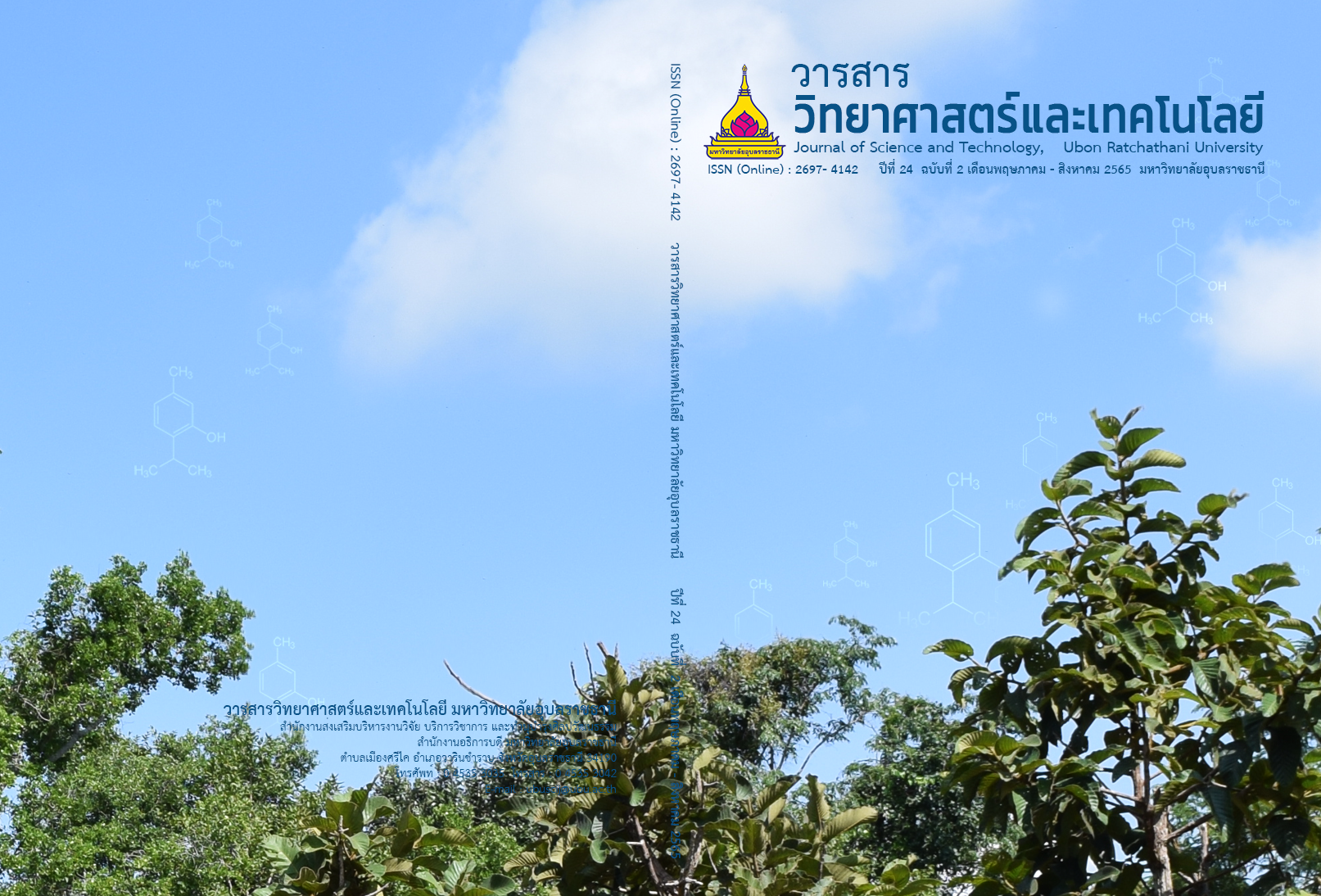การสำรวจชนิดเห็ดบนเส้นทางศึกษาธรรมชาติ พื้นที่อนุรักษ์ป่าต้นน้ำร่องก่อ มหาวิทยาลัยอุบลราชธานี
Main Article Content
บทคัดย่อ
การสำรวจชนิดเห็ดบนเส้นทางศึกษาธรรมชาติพื้นที่อนุรักษ์ป่าต้นน้ำร่องก่อ (ป่าร่องก่อ) มหาวิทยาลัยอุบลราชธานี ระหว่างเดือนมิถุนายน ถึง ตุลาคม ตั้งแต่ พ.ศ. 2561 ถึง 2564 พบเห็ดทั้งหมด 66 ชนิด ใน 2 ไฟลัม คือ ไฟลัมเบสิดิโอมายโคตา (Phylum Basidiomycota) จำนวน 65 ชนิด และ ไฟลัมแอสโคมายโคตา (Phylum Ascomycota) จำนวน 1 ชนิด เห็ดทั้งหมดสามารถจำแนกได้ 10 อันดับ (Order) และ 19 วงศ์ (Family) โดยจัดอยู่ในไฟลัมเบสิดิโอมายโคตา จำนวน 9 อันดับ ได้แก่ Agaricales จำนวน 21 ชนิด Boletalales จำนวน 14 ชนิด Polyporales จำนวน 12 ชนิด Russulales จำนวน 11 ชนิด Hymenochaetales และ Cantharellales พบอันดับละ 2 ชนิด และที่เหลือ คือ Auriculariales Gomphales และ Phallales พบอันดับละ 1 ชนิด ส่วนในไฟลัมแอสโคมายโคตา พบเห็ดเพียง 1 อันดับ คือ Xylariales จำนวน 1 ชนิด โดยเห็ดส่วนใหญ่เป็นเห็ดเอคโตไมคอร์ไมคอร์ไรซา (ectomycorrhizal mushrooms) ซึ่งมีบทบาทในการอยู่ร่วมกับพืชในป่าเต็งรัง และดิบแล้ง ซึ่งเป็นลักษณะเด่นของป่าร่องก่อ แห่งนี้ การศึกษาครั้งนี้ นำไปสู่การส่งเสริมการศึกษาตามเส้นทางศึกษาธรรมชาติ และเป็นข้อมูลในการอนุรักษ์ป่าร่องก่อสืบไป
Article Details

อนุญาตภายใต้เงื่อนไข Creative Commons Attribution-NonCommercial-NoDerivatives 4.0 International License.
บทความที่ได้รับการตีพิมพ์เป็นลิขสิทธิ์ของ วารสารวิทยาศาสตร์และเทคโนโลยี มหาวิทยาลัยอุบลราชธานี
ข้อความที่ปรากฏในบทความแต่ละเรื่องในวารสารวิชาการเล่มนี้เป็นความคิดเห็นส่วนตัวของผู้เขียนแต่ละท่านไม่เกี่ยวข้องกับมหาวิทยาลัยอุบลราชธานี และคณาจารย์ท่านอื่นๆในมหาวิทยาลัยฯ แต่อย่างใด ความรับผิดชอบองค์ประกอบทั้งหมดของบทความแต่ละเรื่องเป็นของผู้เขียนแต่ละท่าน หากมีความผิดพลาดใดๆ ผู้เขียนแต่ละท่านจะรับผิดชอบบทความของตนเองแต่ผู้เดียว
เอกสารอ้างอิง
Sanoamuang, N. 2010. Wild Mushrooms of Thailand: Biodiversity and Utilization. Bangkok: Universal Graphic and Trading Press. (in Thai)
Chanopas, M. and et al. 2006. Survey on macrofungi at Doy Weang La wildlife sanctuary in Mae Hong Son province. NU. International Journal of Science. 2(2): 175-181. (in Thai)
Rattanasuk, S. and et al. 2017. Species diversity of edible mushrooms in Roi Et Rajabhat University forest. Rajabhat Agriculture Journal. 16(2): 27-32.
Pitakpong, A. 2021. Survey of mushroom diversity in forest of University of Phayao. Journal of Science, Engineering and Technology. 1(1): 30-36. (in Thai)
Kesonbua, W. and Udomsirichakorn, K. 2013. A Field Guide to Plants of Ubon Ratchathani University Botanical Garden. Ubon Rachathani: Ubon Ratchathani University Press. (in Thai)
Chandrasrikul, A. and et. al. 2008. Diversity of Mushrooms and Macrofungi in Thailand. Bangkok: Kasetsart University Press. (in Thai)
Chandrasrikul, A. and et. al. 2011. Checklist of Mushrooms (Basidiomycetes) in Thailand. Bangkok: Office of Natural Resources and Environmental Policy and Planning Bangkok, Thailand. (in Thai)
Pukahuta, C. and et al. 2014. Manual of Mushroom Study in Ubon Ratchathani Zoo. Ubon Ratchathani: Ubon Ratchathani University Press. (in Thai)
Pukahuta, C. and et al. 2020. Manual of Mushroom Study in Ubon Ratchathani Zoo. Ubon Ratchathani: Siritham Offset Press. (in Thai)
Naksuwankul, K. and et al. 2021. Classification of poisonous mushroom base on morphological characteristics and indigenous knowledge at Ubon Ratchathani province. KKU Science Journal. 49(1): 40-57. (in Thai)
Zhang, M. and et al. 2019. Phylogenetic overview of Aureoboletus (Boletaceae, Boletales), with descriptions of six new species from China. MycoKeys. 61: 111-145.
Liu, X. and et al. 2007. Antioxidant activity and phenolics of an endophytic Xylaria sp. from Ginkgo biloba. Food Chemistry. 105(2): 548-554.
Kaewgrajan, T. 2019. Relationship between environmental factor and species diversity of wild edible mushrooms at Sakaerat environmental research station, Nakhon Ratchasima province. Thai Journal of Forestry. 38(1): 53-65 (in Thai)


